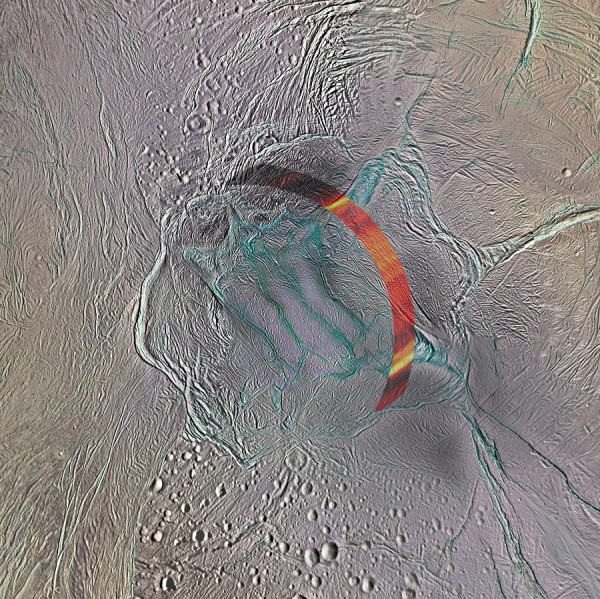By Ana Verayo, | March 18, 2017

Tiger stripes on the south pole of Enceladus. The region studied is indicated by the coloured band.
Saturn's icy moon Enceladus is apparently not just a huge, striped frozen world. A new study reveals that its south pole is emitting unusually warm temperatures, that is also providing clues about the moon's hidden subsurface ocean.
New data obtained by NASA's Cassini spacecraft detected warm temperatures just below its icy surface, indicating that a global ocean underneath is closer to the surface. According to lead author of the study, Alice Le Gall of the the Université Versailles Saint-Quentin in France who is also part of the Cassini radar team, this emanating heat is not just caused by solar heat shining on the moon, it also means that there is also an additional heat source underneath.
Like Us on Facebook
This heat below is indicated by the distinct "tiger stripes" on Enceladus. New imagery from the Cassini spacecraft also revealed how these stripes are apparently massive fractures on the moon's icy crust. Mysterious plumes erupt from here like geysers which most likely consist of brine.
Le Gall explains that this heat was detected via microwave wavelengths, indicating a thermal anomaly. This heat is more pronounced over three fractures however there are no jets ejected at the moment. Mission scientists now suggest that these fractures could be dormant, that is just above a warm, underground ocean over the southern polar region. More specifically, this hidden ocean could be just more than a mile under the surface compared to other regions of Enceladus, estimated at 12 miles on average.
According to the European Space Agency's Nicolas Altobelli, if this underground sea is very close to the surface of Enceladus, this means that a future follow up mission to this moon is necessary to penetrate the ice with a radar sounding instrument to detect this ocean.
Cassini has already conducted a very close flyby near these plumes and jets however, the spacecraft is not specifically designed to detect any biosignatures as evidence of life from the spray. Apart from Enceladus, NASA is already planning to send a follow up mission to Jupiter's moon Europa, which also possesses a hidden ocean underneath its surface.
This new study is published in the journal, Nature Astronomy.
-
Use of Coronavirus Pandemic Drones Raises Privacy Concerns: Drones Spread Fear, Local Officials Say

-
Coronavirus Hampers The Delivery Of Lockheed Martin F-35 Stealth Fighters For 2020

-
Instagram Speeds Up Plans to Add Account Memorialization Feature Due to COVID-19 Deaths

-
NASA: Perseverance Plans to Bring 'Mars Rock' to Earth in 2031

-
600 Dead And 3,000 In The Hospital as Iranians Believed Drinking High-Concentrations of Alcohol Can Cure The Coronavirus

-
600 Dead And 3,000 In The Hospital as Iranians Believed Drinking High-Concentrations of Alcohol Can Cure The Coronavirus

-
COVID-19: Doctors, Nurses Use Virtual Reality to Learn New Skills in Treating Coronavirus Patients







